Be like a Sneaker Ad
Today we’re delighted to have guest blogger Beth Vincelette visit us to discuss her story of learning to spin. We think many of you will be nodding your heads as you read, recognizing your own experiences in Beth’s account.
On a good day, when the planets are properly aligned and the volcanoes have all been appeased with the appropriate amount of virgins thrown into their molten maws, I am a truly mediocre spinner. For years (far more than I am willing to admit, given my level of mediocrity), I have taken classes, attended guild meetings, sent emails to teachers with questions, acquired and read books on spinning. I thought I should be far, far better at this than I am. Then I realized that after I came home from the classes and meetings, after I put the books aside, I was not spinning. I was not making room in my life to practice what I had spent all that time and money to learn. I was afraid of ruining the beautiful fibers I bought at festivals or online and then being disappointed with the results of my supposedly new-found skills. I did not want to end up with another skein of yarn that would just suck. So I avoided the disappointment all together.
It does not take a genius to see the flaw in this plan.
Then, the other day, I came across a snippet of an interview with Ira Glass, host of “This American Life” on public radio. What he had to say about the creative process has since changed everything for me. In essence, he was brutally frank about the fact that beginners in any creative effort are invariably bad at what they are doing. There’s no way around it. You’re new. First attempts at anything are usually going to be terrible. And that’s OK. You need the failures to add up to a body of embarrassingly bad early work in order to progress.
This, although clearly obvious, was still a revelation to me. I felt liberated from the idea that all the classes and guild meetings would somehow automatically turn me into a better spinner. Only one thing was going to make me a better spinner, and that was a LOT of bad spinning.
So I have decided to embrace the suck. I don’t mean the kind of embrace that is a slight pat on the back you give that weird cousin who you really don’t want to spend time with at Christmas, I mean a full-on rib-cracking bear hug with sloppy wet kisses kind of embrace. And it has already paid off enormously.
For one, I finally got around to starting my notebook of yarn samples. I have had the supplies for months, but never got around to putting it all together. Right now it sucks, too, but it’s a start. It will get better as I do.
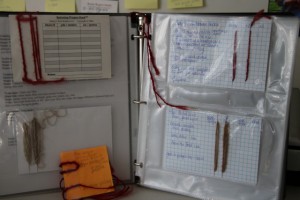 See that little orange sticky note? I’m not sure if you can read it, but it says, “I no longer remember what this is or how it was prepped.” Infinitely useless information, I’m sure, but it’s going in the book. I know this was spun in 2016, and I know its 100% wool of some breed or other. This little sticky note told me that not only do I need to keep more specific records of my work, but that that each sample was spun using a different pulley on my wheel. This makes that note worth saving. My goal for this binder, aside from keeping records of what I have done in the past, is to use it to get inspiration and specific information on fiber prep, drafting, and wheel set-up so I can make better plans for future projects.
See that little orange sticky note? I’m not sure if you can read it, but it says, “I no longer remember what this is or how it was prepped.” Infinitely useless information, I’m sure, but it’s going in the book. I know this was spun in 2016, and I know its 100% wool of some breed or other. This little sticky note told me that not only do I need to keep more specific records of my work, but that that each sample was spun using a different pulley on my wheel. This makes that note worth saving. My goal for this binder, aside from keeping records of what I have done in the past, is to use it to get inspiration and specific information on fiber prep, drafting, and wheel set-up so I can make better plans for future projects.
Next, I pulled out (one bin of) my spinning stash, and went through it, and tried to decide what would be next to go on the wheel. I found all kinds of lovely things that I bought when I was dreaming of being a much, much better spinner. I used to call that fiber “Aspirational Yarn” since it was yarn I aspired to making. All those gorgeous, slippery, short-stapled luxury fibers that have been waiting to see the light of day for far too long: the cashgora, the pygora, camel and yak. The silk caps and super slippery alpaca. The kid mohair locks.
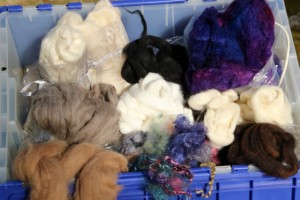 I found a bobbin in a box somewhere with a few yards of camel singles on it from the camel top in the stash bin. They were really, really crappy singles. So I threw that bobbin on the wheel and finished spinning an ounce of camel down using a medium pulley and supported long draw. The single that resulted was certainly acceptable. It’s not great, but it isn’t nearly as bad as my first attempt. I have two more ounces to go, and the next ounce I’m going to try spinning it from the fold, just to see what happens. The third ounce is waiting for inspiration to strike.
I found a bobbin in a box somewhere with a few yards of camel singles on it from the camel top in the stash bin. They were really, really crappy singles. So I threw that bobbin on the wheel and finished spinning an ounce of camel down using a medium pulley and supported long draw. The single that resulted was certainly acceptable. It’s not great, but it isn’t nearly as bad as my first attempt. I have two more ounces to go, and the next ounce I’m going to try spinning it from the fold, just to see what happens. The third ounce is waiting for inspiration to strike.
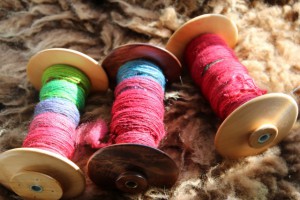 Next up was a beautiful braid of BFL roving dyed in red, greens and blues. To me it looked like a pair of socks fit for a Christmas elf just waiting to be made. I divided the roving lengthwise into six strips and spun a fine worsted single using two strips for each bobbin to make a 3-ply sock yarn. I am hoping the colors will mostly line up, but if they don’t I am not going to lose any sleep over it. The socks will be the first made from my handspun, which will make them special by definition. I don’t care if they suck. They will be the record of my effort and, if they turn out really bad, I know that eventually I will be able to make a better pair.
Next up was a beautiful braid of BFL roving dyed in red, greens and blues. To me it looked like a pair of socks fit for a Christmas elf just waiting to be made. I divided the roving lengthwise into six strips and spun a fine worsted single using two strips for each bobbin to make a 3-ply sock yarn. I am hoping the colors will mostly line up, but if they don’t I am not going to lose any sleep over it. The socks will be the first made from my handspun, which will make them special by definition. I don’t care if they suck. They will be the record of my effort and, if they turn out really bad, I know that eventually I will be able to make a better pair.
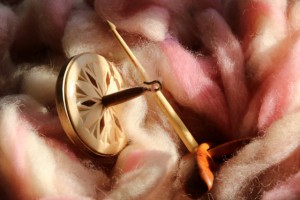 After the socks, I plan on tackling an alpaca blend with one of my spindles; a project which was started years ago. Now THAT is some really sucky yarn… for now.
After the socks, I plan on tackling an alpaca blend with one of my spindles; a project which was started years ago. Now THAT is some really sucky yarn… for now.
So, in the end, my message is this: Just Do It. Start spinning and keep at it. Jump right in be liberated from the fear of failure. Be confident that you will produce lousy yarn. Failure is your friend; learn from it and move on. Embrace the Suck.

Beth is a knitter, spinner & former martial artist who lives in Connecticut with her two boys and a fuzz-eating cat. Her much-neglected blog can be found at www.knitkick.blogspot.com.


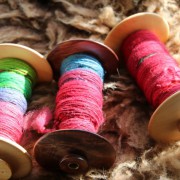

Very funny and so true!! Thanks for the encouragement to keep trying! I am stalled out on several projects right now and this post has given me motivation and a smile.
Hi Jennie,
I am so glad to hear that you found the essay helpful! I have come to think of my progress in spinning as being similar to my martial arts training in so many ways. Nobody expects a new student to perform at a black belt level after only a few weeks of training, just as nobody expects a new knitter to be able to crank out complicated lace or cables in a similar amount of time. But practice, patience, and a willingness to learn from one’s mistakes will eventually result in the mastering of the skills that previously seemed impossible to accomplish.
Me too! My yarn sucks and I love it! I have made one skein of pretty, soft, usable yarn and the rest has been ropey, hard, alternately slubby and precariously weak. But I can see some progress, like you.
I have to remember that I’m a good knitter, but I have been doing it for 41 years! I will be an acceptable spinner (and weaver and sewist), but have to make some crap along the way. 🙂